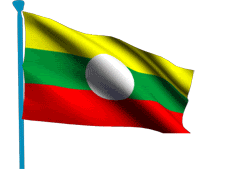Lifestyle and customs of Tai Khamti Lohit, Arunachal Pradesh. India. By :- Chow Bilaseng Namchoom
Lifestyle and customs
The Tai-Khampti people are very strong believers of
Theravada Buddhism. Every house has a prayer room and the families
pray every morning and evening with offerings of flowers (nam taw yongli) and
food (khao tang som).They are peace loving people.
The Tai-Khampti have their own Tai script - Lik-Tai.
They also have varied dwelling systems. Houses of the Tai-Khampti are built on
raised floors with thatched roofs. The roofs are constructed so low that the
walls remain concealed. Wooden planks are used for flooring and the walls are
made of bamboo splices. But with time everything changes, and in this modern
era the style of construction of houses with raised floors and thatched roofs
has been replaced by cement and brick buildings.
The Khampti have a very rich culture, equipped with
magnificent arts and craft. Armoury is a part of their life, representing the
aura of their skill as warriors. Their weapons include poisoned bamboo spikes
(panjis), bows and arrows, spears, swords and shields. The Khampti also have
firearms, resembling ancient flint muskets and horse pistols.
The tribe has a preference for conventional attire,
enriched by brilliant craft work, which command a huge market in the entire
Indian market. The beautifully crafted sword, known as Pha-Nap, is
very popular around the state. The sword is carried on the frontal part of the
body, so that its hilt can be grasped in the right hand if needed.
The Khampti crafts in bamboo, wood, bone and ivory are also
spectacular. They are experts in making traditional weapons. The priests
are also known to be amateur craftsmen who use wood, bone or ivory to carve out
religious statues.
The Tai Khampti people are settled agriculturists. They
use the plough (Thai) drawn by a single animal, either an oxen or a buffalo (or
even an elephant in the olden days). They practice both jhum and
settled agriculture and produce food grains, vegetables and cash crops. Among
food grains, coarse varieties of rice, maize, millet and cotton are important
products of jhum cultivation. Potatoes have been introduced recently.
Among vegetables potatoes, pumpkins, cucumbers and yams are mainly cultivated.
Besides this, tobacco, chilli, ginger and indigo is occasionally grown.


No comments